How to conduct an effective leadership workshop

Great teams are built on a foundation of great leaders. But how do leaders grow and develop the skills necessary to help their teams do great work and collaborate with purpose?
Structured training programs and leadership skills workshops can help provide dedicated space for your leaders to level-up and grow in a collaborative format.
In this guide, we'll explore why your team should invest in the growth of your leaders and share practical advice for how to facilitate an effective leadership workshop.
Let's dive in!
What is a leadership workshop?
A leadership workshop is a collaborative session where new and existing leaders develop the skills needed to be effective leaders and work on personal development.
It’s a structured session that combines solid leadership theory with practical techniques and group discussion in order to fully engage leaders in their own growth.
Your organization might run a leadership workshop to fill a particular training need you’ve identified. For example, a lack of coaching skills might be holding back team development, or the company might be having trouble with group decision making.
A focused leadership development session might be specifically designed to solve those problems and teach your leaders the competencies needed for success.
Leadership workshops are also a great space for new leaders to learn in a supportive, experiential environment, free from the fear of messing up while, for example, giving their first performance review.
Many learning providers also provide training for developing specific leadership skills and core competencies needed to lead a team. It’s quite common for organizations to send team members to learn from experts and network with folks from other companies on these kinds of programs.
Want to see an example of what to expect in a leadership workshop? You might find this leadership development workshop template helpful.
Designed for new leaders, this template offers a 2-day structure to enable leaders to reflect on their leadership style, discuss what makes a good leader and build core skills like active listening, delegation and feedback.
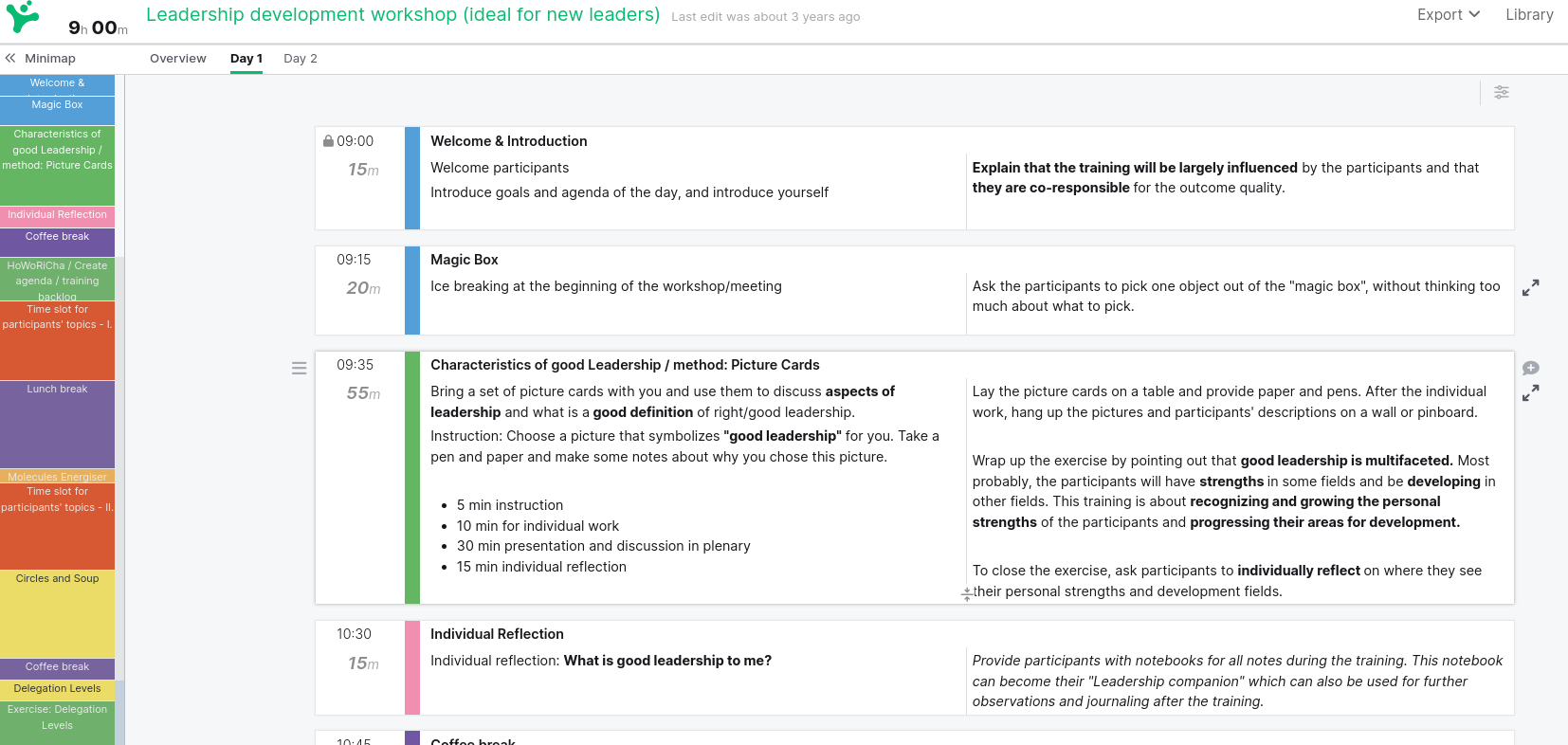
What are the benefits of leadership development?
Good leaders set the tone for the organization and can rally a group towards great things. As such, it shouldn’t be a surprise that investing time, space (and of course, money) in a leadership skills workshop or a fully featured leadership development program can have far reaching effects on your business.
Yes, you can expect to achieve organizational success and meet business KPIs by developing the skillset of your leaders. But it goes deeper than that.
The best leaders I’ve worked with have supported me through career highs and lows, helping me achieve more and grow as an employee. They’ve been great strategic thinkers that have helped finesse the work of others and help guide key decisions with a firm but empathetic hand.
There are many reasons people might quit their job, though as Harvard Business Review notes, a lack of career development or the way people are managed are two of the main contributors to leaving.
Leadership development can help ameliorate this problem from both ends: giving folks meaningful career progression and opportunities for growth and ensuring that everyone in an organization is managed in a more empathic and effective manner.

What are the objectives of a leadership workshop?
In its simplest form, the goal of a leadership workshop is to teach leaders the skills they need to be effective leaders and thus help your teams and organization thrive.
The specific skills being taught or the depth of those skills is likely to differ based on the audience you’re working with. A workshop for new managers may include a broader set of leadership skills than an executive leadership workshop where a level of prior knowledge is already in place and folks want to focus on, say, change management or coaching skills.
In either case, the trainer or facilitator leading the program will determine the best ways to teach those leadership skills, often with a mix of theory, experiential activities and group discussions.
I want to take a moment to highlight those group discussions. In my experience, one of the core objectives of these kinds of personal development sessions is to meaningfully engage learners in their own learning.
You don’t want to just share slides so people can say they’ve learned about effective leadership. You want team leaders to have a great session AND deploy what they’ve learned while continuing to learn and grow afterwards.
One way to achieve this is to create space for leaders to share their experiences on topics like motivating a team or resolving conflicts and learn from one another.
All workshops are built on the collective intelligence of the group, and leadership development workshops are no different.
By tapping into this collective intelligence, you can stimulate folks to take ownership of their own learning and bring those learnings into the realm of the day-to-day, rather than limit the learning to slides or examples that have little to do with their actual experience.
How to conduct an engaging leadership workshop
Planning and running an effective leadership program is more than throwing a bunch of new managers into a room with a slideshow.
Even with an understanding of what good leadership looks like and the kinds of techniques you want to teach, it’s possible for such a workshop to fall flat or frustrate participants by failing to engage them in their own development.
In this section, we’ll share some tips for creating and running a leadership and development program that will engage your learners, achieve your wider goals and ensure that the program is time well spent for all involved.
You’ll have a greater sense of what makes an effective session and find some practical advice for facilitating the leadership development of your team.
All the most effective workshops have an agenda. An ideal learning experience isn’t the result of randomness but a structured flow of activities designed to engage participants and reach a specific goal. Your workshop agenda is the distillation of that structure and flow into a simple, easy-to-follow format.
Agendas are used at various points in the process of designing and running any leadership training program:
- As proof to yourself (and your training team) that you’ve created a structure that will meet the goal of the session (ie: to improve the conflict resolution skills of every participant and help them be more confident managers.)
- As a guide for participants before the session. This helps group members know what to expect, helps them prepare accordingly and fully engage with with the session when it begins.
- As a running order during the session, helping facilitators run training effectively, time-boxing what needs to be time-boxed and also making informed changes if anything needs to change in the moment.
SessionLab is an effective agenda planning tool that helps optimize your workflow and deliver an engaging leadership training program.
At the design stage, SessionLab makes it easy to quickly structure your agenda. Drag, drop and reorder blocks to create your running order and add color categories to quickly see how balanced your learning flow is.
As you make changes, SessionLab will automatically recalculate your timings – no more manually amending your times any time something shifts.
Once your leadership workshop is ready, you can instantly export a professional quality agenda to share with participants and stakeholders. PDF, PPT, Word or an online agenda: however your team wants to review the agenda, SessionLab has you covered.
Want to learn more? Discover how SessionLab has helped boutique consultancy Cultivating Leadership design effective leadership development workshops at scale.
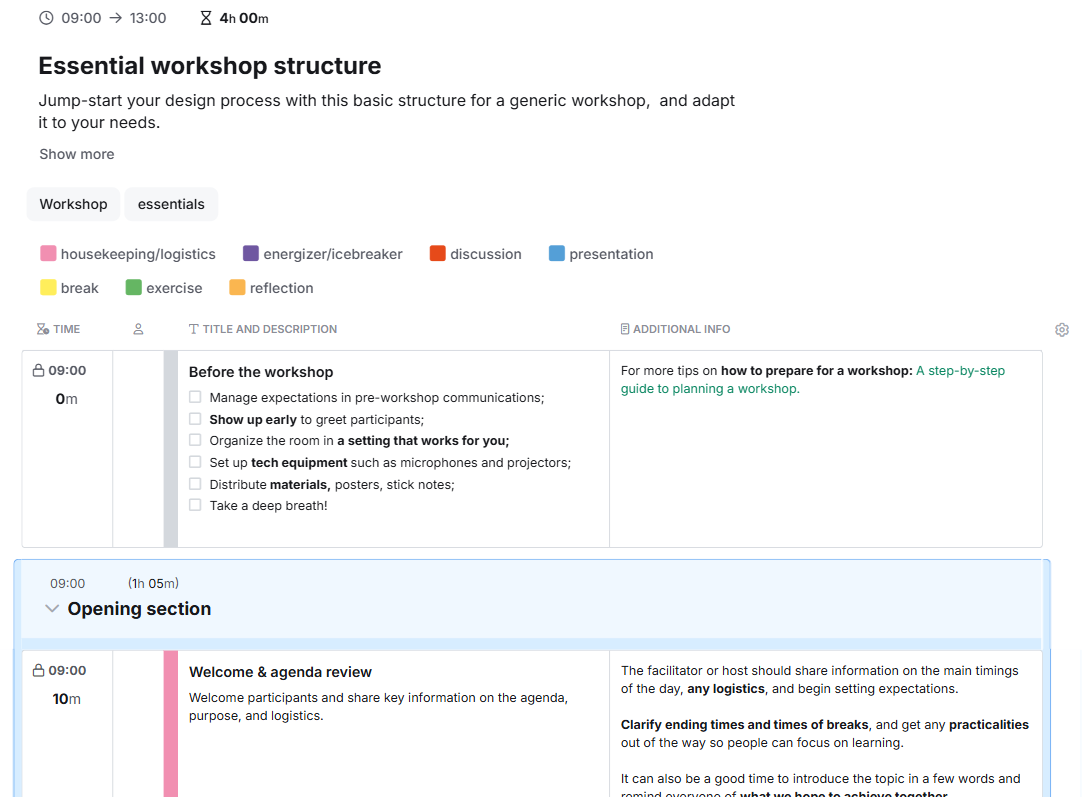
Make what you’re doing (and why) clear
While child learners can sometimes be expected to trust their teacher implicitly, adult learners often need to know why they are doing something in order to fully engage with an activity or learning experience.
As such, it can be helpful to give members of your leadership workshop a clear sense of context for why you’re doing something and a sense of why it will help them achieve the goals of the session. Launching into an oblique training activity without proper framing can put you at risk of losing your audience.
This idea extends to the overall objectives of the session. Start by stating the objectives of the session at the beginning of the workshop. Then go deeper. Why is learning these skills important? Why do we as an organization want to have better leaders? What does that enable us to do as a team?
Making the deeper purpose explicit early in your leadership development programs can help ensure buy-in and get people invested in their own learning.
It can also be helpful to invite participants to ask this question of themselves. Why are you a leader? Why is becoming a better leader important to you? Using an activity like The 5 Whys can help anyone undergoing leadership development understand the deeper purpose behind what they’re doing.
In my experience, that deeper purpose is often much more motivating than the surface goal of an individual session. For example, the first level for undergoing leadership development might be “to advance in my career.” or “because my recent performance review showed a lack of communication skills.”
Fair enough, but if we go deeper, we might find that the reason you want to improve as a leader is to have an impact doing something you deeply care about and to connect more to the people you work with on a human level.
Help the group see the deeper purpose behind the training program as well as connect to their own purpose, and you are much more likely to enlist your group in the session.
Connect to personal goals
Great leaders (and teams) come in all shapes and sizes. While there are universal leadership goals that are worth exploring, many leaders have more specific reasons for wanting to deepen their skillset.
Encouraging participants to connect to their personal goals during any leadership development activity can help them take a more active role in learning and ultimately develop in the way that’s best for them. So how do you do this? Simple: just ask them!
It can be helpful to start a leadership development program with some self reflection activities where participants think about their strengths, opportunities and what they’d like to come away with. Even a framing question like “What kind of leader do you want to be?” or “How will I know this workshop has been useful to me?” can have a powerful impact here.
Even if the main content of the workshop remains the same, this lens can help participants think about what they’re learning during the session on a more personal level.
This can look like participants learning how to embody their personal values while being a leader or utilizing a leadership style that most aligns with how they want to show up in the world. Reflection and goal-setting techniques such as the GROW coaching model can be especially effective for this if you have time for them in your agenda.
In any case, the end result is a deeper engagement with learning and development that is likely to be better for all involved.
Balance activities to allow a mix of voices and create space for reflection
Whenever you bring a group of people together, you’re likely to find a mix of dominant and less dominant voices. Some leaders are quite used to being the loudest voice in the room and often have strong opinions about how things should be done.
Conviction and well-informed opinions are great, but it’s vital to create space for divergent ideas and to balance conversations and discussions.
Use activities like 1-2-4-All to ensure that folks engage with your leadership training topics in a balanced fashion.
For example, you might want to ask people to consider what advice they’d give for de-escalating conflict in silence, taking their own notes. This way, they’ll first be able to organize their thoughts and explore in a safe environment, before sharing with someone else. Moving to a pair discussion also helps ensure that all parties are listened to and feel heard before you then open up to larger groups.
Contrast this with an open discussion where anyone can put up their hand to speak. It’s much more likely that a small number of will folks dominate; even in a well moderated discussion, its unlikely that everyone will actually get the chance to speak and be responded to in the same way as 1-2-4-All.
Try doing this kind of activity early in your session. It’s a great way to build trust, ensure everyone is comfortable with speaking. It’s also useful in order to exercise that self-reflection muscle which is a key part of retaining and deploying anything participants learn during the leadership training.
Be conscious of power dynamics
Power dynamics will naturally occur in any group setting, including leadership workshops, all the more so if you’re running an internal workshop with folks of different levels and seniorities. Without a sense of structure and safety it can be hard for frontline managers to take up space among senior leaders.
Expert facilitators and trainers will typically use intention setting activities and perhaps set some workshop ground rules at the outset of the session that allow everyone to participate equally.
This can also look like having a firm hand on group dynamics and carefully guiding discussions. 1-2-4-All is yet again a great activity here, though you might also find being explicit and directly name group dynamics as they play out can be helpful when course correcting behaviour. Check out our post on group facilitation for more on building this skill!
Framing the session with power dynamics in mind can also help. For example, “This workshop is about every leader in this room getting better at giving coaching to their team and learning from one another” can be a more effective inclusive framing device than “Let’s learn from the experts.”
In its simplest form, you might address these dynamics by, well, directly addressing them! A group contract at the start of your leadership training that makes how you want folks to interact explicit can do wonders.
Lead by example
One of things I love about leadership workshops is that they provide multiple opportunities for groups to learn about effective leadership. The activities you choose, the examples you share and the discussions the group have: all these are important, but how the session itself is facilitated can also be a powerful learning tool.
During the session, an expert facilitator or trainer will hold space for a diverse group to all contribute towards a shared goal, managing expectations, getting results and helping everyone achieve their best.
Sounds a lot like good leadership, doesn’t it? In fact, I find many aspects of good facilitation to be synonymous with those of good leadership.
While this might feel a bit meta, the key takeaway here is to think of the session itself as a way to demonstrate some core leadership skills in action and provide trainees with a clear example of what good looks like through your facilitation.
Obviously, it’s important to know your limits. You can likely model great soft skills and how to manage group dynamics while facilitating, but you may not be able to effectively plan a company strategy. Own what you know and defer on what you don’t. (Yes, that’s another example of leading by example!)
If you want to explore this further, our guide to facilitation skills may help you figure out how best to hold space when leading such a session.

Don’t be afraid to go back to basics
Leaders are often very skilled, but they’re not infallible. Leadership workshops are a great place to challenge assumptions and also go back to basics.
You might be surprised by how many leaders have risen to an executive position but have holes in their skill set, especially when it comes to soft skills. And that’s okay! No one can be expected to be great at everything. The goal of many leadership development programs is for leaders to safely identify what needs to be improved and then take steps to improve.
Though this depends on the scope of your leadership training program, you may begin by determining competency with a group discussion or using experiential activities that allow folks to demonstrate their skills and knowledge on subjects like effective feedback or communication.
The results of such an exercise might mean you can move ahead quickly or need to go back and spend more time shoring up core competencies.
Self assessment is another impactful way to get learners thinking about strengths and opportunities alike. Leadership Pizza is a great tool for any leadership program that includes self assessment and goal setting as part of the curriculum.
Whichever way you go, take steps to create psychological safety in the group before discussing competency. I’d recommend creating a group contract or doing some warm-up activities where your team get to know each other a little better before asking folks to share their weaknesses with the group.
Use examples and case studies (but encourage personal stories too!)
Examples and case studies are great, but first, let me share a confession: if I have to listen to the same story about Steve Jobs during a training session one more time, I might scream!
Choosing the right examples and case studies is heavily dependent on your group and the tenor of your session. For example, your group of technical founders might benefit from how leaders in their sector have brought their teams together while scaling with very specific, practical examples.
On the flip side, if the focus of your leadership training is on softer skills, inspiring examples from outside the sector might be more useful. Aim for relevancy and for examples that will chime with your group – don’t just go for the old standards. (Sorry, Steve!)
I’d also say that personal stories from the group can often be more powerful than an example from some business guru folks can’t relate to.
Personal stories give folks an opportunity to share their learnings, form connections and go deeper in a way that a slideshow just can’t. This approach is based on sound learning theory and so it’s a vital technique for engaging leaders in the workshop too.
Appreciative Interviews is a powerful technique for encouraging examples from the group that both enable learning and reflection. By focusing on success stories in small groups, you can help facilitate this peer learning and support pretty easily!
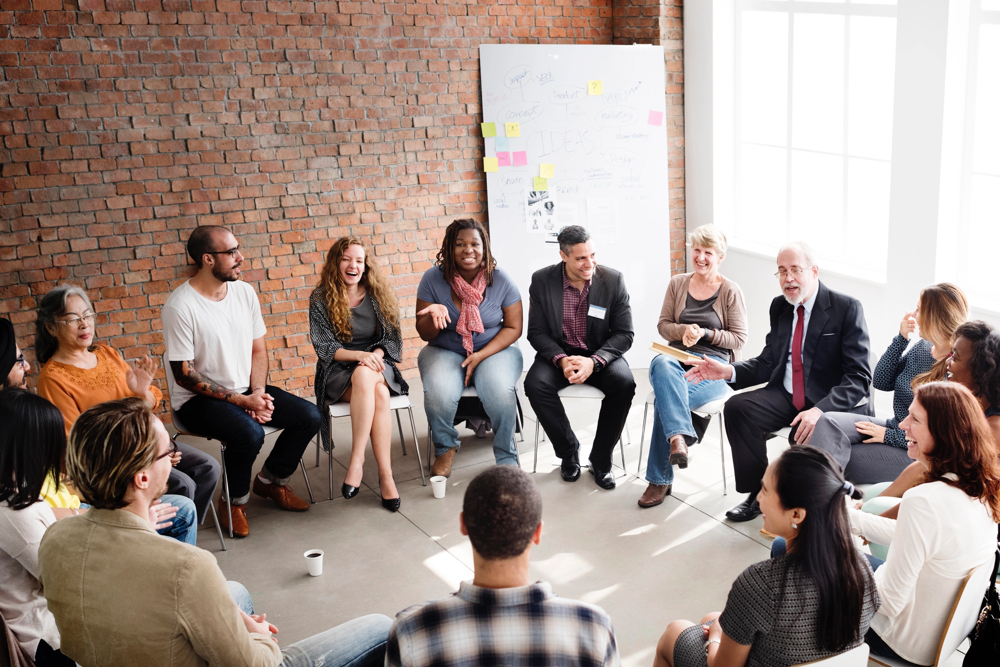
Give your leaders practical, easy to action tools
Giving leaders practical tools they can action the next day is a hallmark of effective leadership training.
In many cases, it can be extremely effective to share a leadership technique with the group, get them to practice it together and then encourage them to take the tool away with them and use it with their team. A great example is the Heard, Seen, Respected activity from the Liberating Structures toolkit.
Here, you would get your trainees into pairs where they would take turns sharing a story about a time where they did not seen heard, seen or respected. While one person shares, the other person would listen without trying to fix the situation or leap to judgment.
By experiencing this technique firsthand, leaders would then be able to deploy it when working with their own direct reports and have a sense of how powerful it can be to just be listened to.
This is just one example of making leadership development both experiential and practical. Discover more techniques you can bring to your session in our collection of effective leadership training activities.
What about leadership training programs?
Good leaders are seldom born, nor are they made in a single leadership workshop. A training session can be a great way to start closing a skills gap, but true and lasting growth occurs when these factor into an ongoing process of practice, learning, coaching and continued leadership development.
But what do these look like? Your own L&D team will likely have a specific approach that works for your organization, but often this is a cyclical process of:
- discovering a skills gap or potential new leaders in need of development
- enrolling people on a program of leadership development which is often a combination of:
- skills development workshops where a cohort learns collaboratively;
- self-directed learning in line with the goals of the program and the individual learner. This can include webinars, books and self-paced courses;
- coaching, whether from experts or in the form of peer coaching;
- skills practice and reflection. Leaders will often put learnings into practice with their team and reflect on their growth;
- 1-1s and check-ins with supervisors;
- program feedback, reflection and iteration
Broadly speaking, leadership development programs offer an ongoing structure to help new leaders grow and existing leaders improve over long periods of time. However these are initiated, you will typically determine a skills gap or developmental goal and deploy a means to fill it. You’ll then reflect on the process, improve it, then repeat.
The ongoing nature of a leadership development program is a great fit for peer support groups and cohort-based learning. Get your new managers and team leaders to meet on a regular basis, whether formally or informally, and they’ll all benefit from their shared experiences.
Internal leadership development programs are also an effective means to share your internal best practices and standards for leadership. They’re a place where you’ll talk about your company values and how you wish to see them demonstrated by your leaders and the team they work with.

What’s next?
Whether it’s your senior leaders or your frontline team leads, everyone should have the opportunity to grow. Investing in the personal development of your leaders and giving them the skills to drive organizational success can be one of the most impactful ways to empower your business.
I hope we’ve given you some practical ideas for running a leadership development workshop that has impact and will help enlist your team in their own leadership training.
Check out the leadership development workshop template for an example of an ideal structure for developing the skills of new leaders. Easily adjust the agenda to your needs or just get inspired!
Looking for techniques and activities to use during your workshop? Our post on leadership games and activities has you covered with over 30 practical techniques your team will use long after your leadership training is complete.
Finally, when it comes to designing your workshop, it’s important to think about learning flow, activity balance and structure. Check out our guide on how to plan a workshop for a step-by-step guide for turning that initial needs assessment into a final workshop.
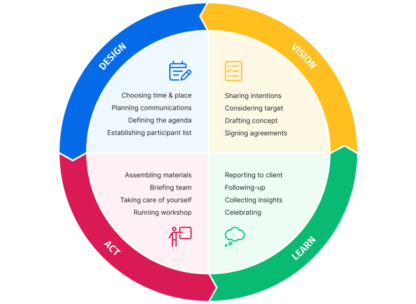

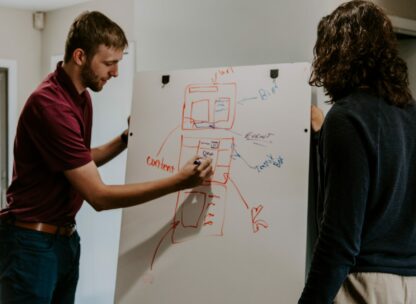
Leave a Comment